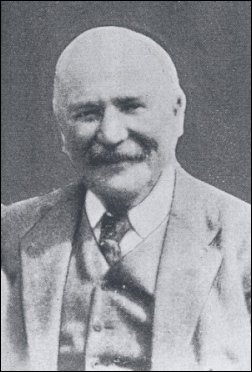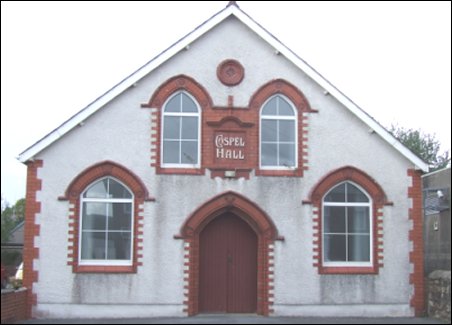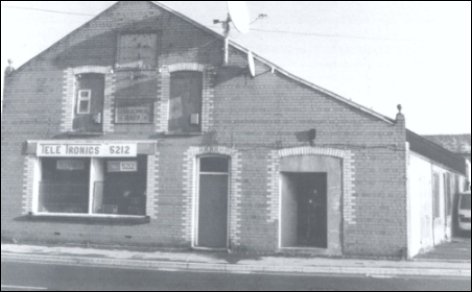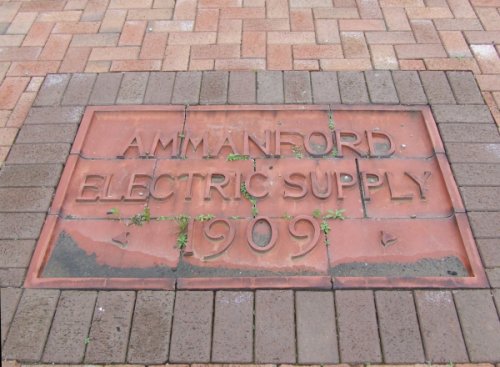AMMANFORD ELECTRIC HOUSE
HOW ELECTRICITY CAME TO AMMANFORDWILLIAM HERBERT
William Herbert, gospeller and industrialist. Church leaders are often credited with bringing spiritual light into the lives of their flock. Few, if any, go a stage further and bring real light to their town as well.
Mr William Herbert (1859-1937) of Llwynon, High Street, was the prime mover behind the growth of a small Protestant church in Ammanford known as the Plymouth Brethren. He started preaching on the streets of Ammanford in 1888, initially to little effect, and by all accounts he cut a lonely figure as, bible in hand, he addressed anyone who cared to stop and listen to him.
But thanks to the eventual conversion of a small but dedicated band of fellow evangelisers, he was well placed to take advantage of the fervour generated by the great Welsh religious revival of 1904-05, when he gained several new followers who were destined to be long-serving members of his fledgling church.
By 1911 church membership had grown sufficiently for these fundamentalist Christians to build a small church in the town which they called the Gospel Hall. As an instigator of the new Gospel Hall (and a leading benefactor) William Herbert had a significant influence on the design of the building, and his shrewd approach to detail ensured the floor of the new hall was constructed with a built-in slope, the object being to discourage the premises being used for any purpose other than preaching the Gospel.
The Gospel Hall, home of Ammanford's Plymouth Brethren. It was built in 1911 with a sloping floor to discourage the hall being used other than to preach the Gospel (no dancing!) But he was also one of the town's most influential entrepreneurs and he and his brother Henry were major players in Ammanford's industrial development at the beginning of the twentieth century.
John and Mary Herbert of Cathilas Farm, Heolddu, were proud of their children, who in their respective fields had a considerable effect on the development of Ammanford. The eldest son, Mr. Henry Herbert of Brynmarlais, Bonllwyn, a Justice of the Peace and local councilor, took a leading part in the development of both Ammanford and Pantyffynnon Collieries. He also contributed to many major civil engineering schemes in the area such as the introduction of the town's water and sewerage systems. Anne Herbert married Evan Evans (the chemist) of Gwynfryn, College Street, who built the multi-story block of business premises in College Street that makes up today's Ammanford Square. It was he who also built the Arcade of shops leading to the now-vanished Palace Cinema, also his creation. Herbert Herbert, the youngest of the children, qualified as a doctor, setting up in practice in Tumble, and finally we come to William Herbert of our story who involved himself in various business ventures while also being active in the local branch of the Plymouth Brethren.
William Herbert had became a converted gospeller after attending a religious meeting on his emigration to New Zealand in 1884. Though his family in Ammanford were all Independents, such was his commitment and dedication to the new cause that after his return to Ammanford in 1888 he was often seen at the street corners of the town with his Bible in hand, preaching to rather startled passers-by, not used to the style of open-air preaching that he employed. Ammanford's main churches and chapels were long-estabished in the area and didn't need active recruitment to attract worshippers. Quite the opposite, in fact, as the town in the early twentieth century was growing rapidly, and chapel membership was growing alongside the town's development. These chapels saw no need to brave the elements and stop the town's good folk with amdomishments that they had to be 'born again' to ensure eternal life.
Wiliam Herbert's time in New Zealand had been spent in the timber trade and he took over and developed the Baltic Sawmills on Park Street in the early part of the century until its sale in the 1920s. Over the years such a small-scale business became uneconomic and the Baltic Sawmills ceased trading in 1988. After its abandonment that year it was subject to increasing vandalism until purchased by the local council in 1990, and was eventually demolished and replaced by a custom-built government Benefits Agency in 1996.
But in 1909 William Herbert embarked on another enterprise of even greater significance to the town: the establishment of the electricity generating station known as the Power House, which he built across the road from the Baltic Sawmills. We take the supply and use of electricity today for granted and think nothing of the matter, at least until the bills arrive, but it's worth making a short detour in this story about an obscure local church to gain an insight into how electricity arrived in our little town (and also see how the Protestant work ethic operates in practice).
The Power House
As an integral part of the operation of the Baltic Sawmills William Herbert installed electrical generators to drive various motors and for lighting the premises. Following a common practice of the day neighbouring properties enjoyed the privilege of connecting into these circuits as a private supply.Coal gas (commercially viable since 1802 and extensively used as a lighting medium) was available in most of the adjoining towns and hamlets by the 1890s. For some unknown reason, Ammanford and the Amman Valley did not attract such investment until around 1905, when the Amman Valley Gas Light Company was formed and it took yet another four years before they were able to distribute a supply of gas to individual homes in the district.
William Herbert quickly realised the huge potential of the new technology of electricity as a competitive source of power for industry and lighting for homes. In 1909 he opened the Power House in Park Street and started to generate electricity for sale to private consumers as a commercial venture.
Ammanford Power House in the late 1990s, ninety years after its birth and sixty years after it was abandoned as an electricity generating plant. It was demolished in May 2006 to make way for a road bypass. Negotiations took place with the Ammanford Urban District Council to establish the rights to erect poles on various roads for a distribution network through overhead cables. The formal agreement signed between the two parties later proved to be loaded in favour of the local authority, who more or less set themselves up as the consumers' watchdog, overseeing the charges which the operator could bill for the electricity supply.
At times the constant wrangling between the two parties over this and other contentious issues became quite embittered. In March 1924, the Ammanford Urban District Council finally resolved to buy out William Herbert and become the sole owners of the electricity distribution at a cost in the region of £17,000. The pound in 1924 had the purchasing power of £29 at today's rates (Bank of England figure) so the sale of the Power House brought William Herbert £500,000 in today's money. As he also sold the Baltic Sawmills at the same time he was quite a wealthy man by anyone's standards. How William Herbert squared this with Christ's numerous denunciations of wealth only a spiritualist can tell us now. If the Bible he always carried with him was the same as ours today, the New Testament still tells us the following:
"Lay not up for yourselves treasures upon earth, where moth and rust doth corrupt, and where thieves break through and steal." [Matthew 6:19] "Jesus looked around and said to his disciples, How hard it is for the rich to enter the kingdom of God! The disciples were amazed at his words. But Jesus said again, Children, how hard it is to enter the kingdom of God! It is easier for a camel to go through the eye of a needle than for a rich man to enter the kingdom of God." [Mark 10: 23-25] "Come now, you rich, weep and howl for your miseries that are coming upon you! Your riches are corrupted, and your garments are moth-eaten. Your gold and silver are corroded, and their corrosion will be a witness against you and will eat your flesh like fire. You have heaped up treasure in the last days." [James 5:1-3] But the purchase of the Power House by Ammanford Urban District Council didn't provide Ammanford with a trouble-free electricity supply. Besides the administration difficulties of managing a publicly owned business, with the laborious referrals and decisions of the Electricity Committee appointed by Council, other problems were soon in evidence. For one, the privately owned Llanelly Electrical Supply Company obtained an order to construct their own distribution network in the area, encroaching on what had been an exclusive monopoly of the Council until then. Ammanford Colliery was the first company to take up the alternative option and many more followed.
To encourage the use of its own electricity, the Council embarked on a series of ambitious sales promotions, offering deferred payment terms, holding demonstrations of various household appliances in the Drill Hall, and advertising in local newspapers. One such notice appeared on the 5th of January 1928 giving details of the hire of a vacuum cleaner with a slogan – "five hours of household drudgery done for the cost of one unit of electricity". The writers of advertising slogans still had a lot to learn.
The increase in the use of electricity by domestic and commercial consumers created major complications, and the 180,000 units per day produced by the Council-owned generating plant at Park Street were unable to meet demand without complete restructuring. An agreement was reached in 1933 with the Llanelly Electrical Supply Company for the purchase of bulk supplies to redistribute through the existing Council network. The generators and plant at the Power House, now redundant, were shut down and in time dismantled. But nothing is ever simple, and these changes also led to further complications involving the switchover from the Council's DC (direct current) supply to the AC (alternating current) of the Llanelly company, and countless appliances, motors, wireless sets etc., had to be modified or even replaced.
In 1935 a rather macabre proposal appeared before the Council to convert the now defunct Power House buildings into a mortuary, though this idea was thrown out after objections received from seven local residents. The Ammanford Volunteer Fire Brigade later occupied part of the premises as the Town's Fire Station.
The Ammanford Urban District Council continued to operate the town's electricity supply right up to the nationalisation of the industry in 1948, when all assets were taken over by the South Wales Electricity Board. The Power House building was used by numerous business ventures after nationalisation, resistant, for a few years at least, to all the changes elsewhere in the town. But the writing was on the wall for the old place, and its doom was finally pronounced in May 2006 when it yielded to the unfriendly advance of a bulldozer. A bypass, dodging around the south side of the town centre and diverting traffic up the Amman valley, is now the future for this part of Ammanford.
Fortunately, the company building the bypass, Costain, had the foresight to rescue the name-plate of the power house with its creation date, and embed it into a brick roundabout facing the former site. A small gesture to Ammanford's past, perhaps; nevertheless, it's a gesture that many developers who've demolished other parts of the town's architectural heritage haven't bothered to make.
The Plymouth Brethren today
William Herbert's Power House may be no more but his other creation, the Gospel Hall, has proved a little more durable. The Plymouth Brethren continue to worship in their little church, sloping floor and all, and can even be seen occasionally evangelising on the streets of Ammanford in the spirit of their founder William Herbert, advising all and sundry to prepare to meet their doom. Unfortunately for the Brethren, a new religion, shopping, has replaced the two thousand-year old Christianity on Ammanford's streets. Its worshippers, called consumers, seem far too preoccupied to take heed of this rather drastic warning, preparing to meet (and even exceed) their credit limits instead.Ammanford's Plymouth Brethren also suffered from a split in the 1970s which resulted in the formation of Ammanford Evangelical Church by a breakaway group in 1977. For many years after their creation the Evangelicals led a nomadic life, very much like their parental Plymouth Brethren before them, and various venues were used for their worship including Ammanford Pensioners' Hall and the local St John's Ambulance premises. Finally they raised sufficient funds to purchase and restore the abandoned English Wesleyan Church on Wind Street. They opened the building for worship in 2003 and have today one of the town's largest congregations, having used the intervening years to build up their membership.
For those who'd like to find out more about William Herbert, the full text of his biography can be found in the 'People' section of this website or by clicking HERE.
Date this page last updated: October 1, 2010




